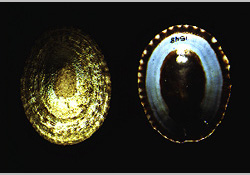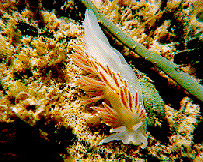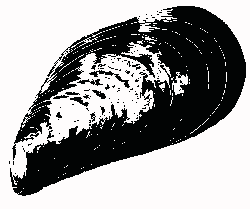
You may recognize the blue mussel (bottom; right) because of the fact it is edible. You may buy it at the store, but in the ocean you'll find it in intertidal and subtidal zones, firmly attached to rocks, if in the early part of its life. These edible bivalves attach themselves with byssal threads, though they can detach, and move using their foot. A blue mussel will eat by oppening its shell under water and staining microscopic food through their gills. This type of feeding is known as filter feeding. Though be carefull not to confuse the Horse Mussel with its blue relative. Horse Mussels are dark brown and non-edible.

What is shown above is called a red gilled nudibranch. You may see one of these in lower intertidal and subtidal zones. These snails lack the true gills and shell of other mollusks. Infact the slug-like animals breathe through projections on their backs! Red projections with white tips stand out, but other animals stay away from the red-gilled nudibranch. This is so because these carnivors actually eat the stinging cells of hydroids and anemones, the stinging cells later come through their body and form the projections.
